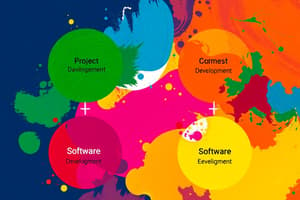Podcast
Questions and Answers
What is the primary goal of requirement engineering in software development?
What is the primary goal of requirement engineering in software development?
The primary goal is to analyze and validate requirements to ensure they fulfill the needs of the stakeholders.
How does the Agile modeling approach differ from the Waterfall model?
How does the Agile modeling approach differ from the Waterfall model?
Agile modeling is a flexible, iterative method that allows for changes throughout development, while the Waterfall model is a sequential approach where changes are less easily accommodated.
What is the significance of cost estimation in software project management?
What is the significance of cost estimation in software project management?
Cost estimation is significant as it helps in budgeting, resource allocation, and determining the financial feasibility of a project.
Define functional modeling in the context of software design.
Define functional modeling in the context of software design.
What is the purpose of risk management in software project management?
What is the purpose of risk management in software project management?
Explain the concept of maintainability in software maintenance.
Explain the concept of maintainability in software maintenance.
What are the key characteristics of the Spiral model in software development?
What are the key characteristics of the Spiral model in software development?
What is the importance of quality assurance in software engineering?
What is the importance of quality assurance in software engineering?
How does black box testing differ from white box testing?
How does black box testing differ from white box testing?
What is Halstead size estimation, and why is it used?
What is Halstead size estimation, and why is it used?
Flashcards
What is the Waterfall Model?
What is the Waterfall Model?
The "Waterfall Model" is a traditional software development approach where each phase of development is completed sequentially, flowing like a waterfall from one stage to the next. Planning, requirements gathering, design, coding, testing, and deployment occur in a linear fashion without overlapping.
What is the Prototyping Model?
What is the Prototyping Model?
The "Prototyping Model" focuses on creating a working prototype of the software, even if it lacks some features, to get early feedback from users and refine requirements. This iterative process allows for adjustments based on user feedback and helps clarify the final product.
What is the Spiral Model?
What is the Spiral Model?
The "Spiral Model" combines elements of both the Waterfall Model and the Prototyping Model. It follows an iterative approach, with each iteration involving planning, risk analysis, engineering development, and evaluation. The spiral model allows for revisiting earlier steps as new information or risks are identified.
What is the RAD Model?
What is the RAD Model?
Signup and view all the flashcards
What is the Agile Model?
What is the Agile Model?
Signup and view all the flashcards
What is the problem analysis phase of Requirement Engineering?
What is the problem analysis phase of Requirement Engineering?
Signup and view all the flashcards
What is the Requirement Verification phase of Requirement Engineering?
What is the Requirement Verification phase of Requirement Engineering?
Signup and view all the flashcards
What is the Requirement Validation Modularity phase of Requirement Engineering?
What is the Requirement Validation Modularity phase of Requirement Engineering?
Signup and view all the flashcards
What is White Box testing?
What is White Box testing?
Signup and view all the flashcards
What is Black Box testing?
What is Black Box testing?
Signup and view all the flashcards
Study Notes
Software Engineering Overview
- Software engineering encompasses introduction, importance, evaluation, characteristics, and components.
- It includes various software applications.
- Different software development models exist, such as waterfall, prototyping, spiral, RAD, and agile.
- Requirement engineering involves problem analysis, requirement verification, and validation modularity.
- Software project management includes cost estimation, project scheduling, risk management, and quality assurance.
- Project monitoring utilizes various estimation techniques (size estimation - LOC, function count, cost estimation, Halstead size estimation).
- Software design involves analysis, modeling (functional, behavioral, unified modeling language), and architecture.
- Data design includes data modeling and data structures.
- Software testing covers white box (unit and integration) and black box (system level, regression).
- Software maintenance involves characteristics, maintainability, tasks, and side effects.
- Current trends in software engineering are also relevant.
Studying That Suits You
Use AI to generate personalized quizzes and flashcards to suit your learning preferences.




